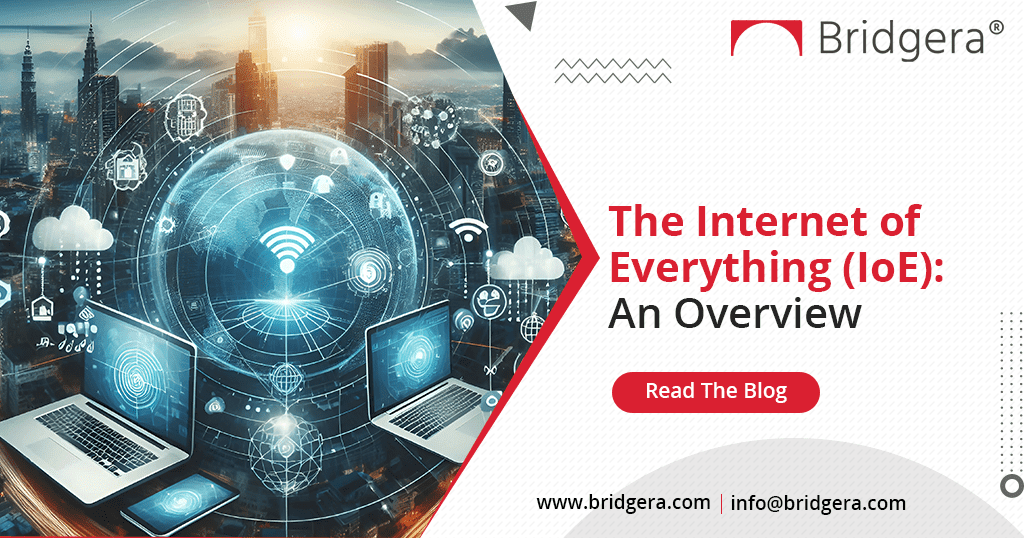The Internet of Everything (IoE) is a concept that goes a step beyond the Internet of Things (IoT). The concept originated at Cisco in the 1990s where they first defined the Internet of Everything (IoE) as “the intelligent connection of people, process, data and things.”
Essentially, with IoE, businesses can now create a robust network of interconnectivity between people, objects, processes, data, and applications. For example, any ordinary object can now be enhanced with digital features. This creates a network of interconnected devices, appliances, and objects that continuously transmit data over the network through sensors.
In this article, we’ll break down the essential components of IoE, its critical applications for businesses, the top challenges facing IoE implementation, and its impact on workforce dynamics.
What are the Key Components of IoE?
The components of IoE go a step further than IoT which prioritize machine-to-machine (M2M) communication. IoE also encompasses machine-to-people (M2P) and people-to-people (P2P) communication. The core components of IoE include:
- People: The human element is a significant part of IoE. Each person generates a wealth of data with every interaction with a connected device. These devices could range from fitness trackers, to smartphones, to interaction with websites and applications through their smartphones. This data is then analyzed by companies for better business decisions and insights. People are nodes in the network of IoE.
- Processes: As ever-increasing volumes of data are gathered through vast networks of interconnected devices, artificial intelligence, machine learning, and IoT-based processes are used to analyze these vast data sets. These processes help develop efficient and effective workflows and improve their business strategies.
- Data: Every device that’s connected to the IoE generates data. When this data is collected and aggregated into processed data, it is a valuable source of insights for businesses.
- Things: In IoE, things refer to devices, machines, or any kind of asset that leverages sensors and actuators to communicate across the network. These things in the IoE ecosystem could be anything ranging from fitness trackers to industrial sensors. In 2024, there were 18.8 billion connected devices globally, and this is expected to exceed 29 billion by 2027.
Benefits of IoE for Businesses
Beyond just cost savings, here are some of the benefits of IoE for businesses across industries
- Increased efficiency: By automating processes, improving workflows, and decreasing human errors, IoE can greatly improve efficiency across industries.
- Real-time, accurate data for enhanced business decisions: IoE networks gather vast amounts of data across devices in real-time. This data helps business leaders make the right decisions based on future opportunities and historical data.
- Improved customer satisfaction: By leveraging the power of IoE, businesses can provide better customer satisfaction to long-term customers.
- Improved supply chain management: IoE can enable enhanced supply chain management and prevent bottlenecks. It can help identify issues before they happen and help prevent them.
- Innovation and sustainability: The IoE opens up new avenues for innovation and growth for businesses. Businesses that are able to innovate and meet genuine needs within the economy are likely to succeed in Industry 4.0. In addition, IoE can supplement sustainability by optimizing energy consumption, minimizing waste and by creating efficient workflows.
Some Challenges Facing IoE Implementation
Despite the significant opportunity for industries leveraging IoT, there are significant issues that must be collectively addressed.
Data security and privacy
While interconnectivity offers many advantages, it also makes the devices more vulnerable to cyber-attacks. Cyber breaches not only erode trust with customers, but iprove to be expensive for companies too. Thus, top-notch encryption and security have to be built into each layer of the system to ensure the privacy of sensitive user data and to maintain customer trust.
Interoperability issues
For effective communication to start yielding proper returns, interoperability issues must be addressed. Thus, adhering to standards and protocols becomes more important than ever.
Complexity and scaling up
IoE networks are complicated, requiring specialized expertise and understanding to ensure that the systems deliver the results and are able to scale up when the need arises. IoE devices may not be compatible with older systems which can create challenges for companies integrating their old systems. With the right planning and management, this can be managed.
Impact of IoE on Workforce Dynamics
As businesses across industries adapt to and thrive with IoE networks, what impact does it have on workforce dynamics? As the cost of data storage goes down and the demand for specialized skills goes up, it may lead to more collaborative workspaces where humans interact with skilled machines and systems rather than interacting as operators. This could also lead to increased flexibility and a global talent pool.
The Right IoE Partner Can Make a Difference
As you scale up your operations, the right IoE partner makes a difference in the success of your projects.
At Bridgera, we’re committed to helping you scale your operations and improve your IoE initiatives. Contact one of our IoT and IoE experts today for a free consultation.
About Bridgera: Bridgera effortlessly combines innovation and expertise to deliver cutting-edge solutions using connected intelligence. We engineer experiences that go beyond expectations, equipping our clients with the tools they need to excel in an increasingly interconnected world. Since our establishment in 2015, Bridgera, headquartered in Raleigh, NC, has specialized in crafting and managing tailored SaaS solutions for web, mobile, and IoT applications across North America.
About Author: Krishna Varma is a writer and researcher, who enjoys writing about technology, IoT, and lifestyle. When she isn’t writing and reading, you’ll find her relaxing with a quiet cup of tea over the weekends.
